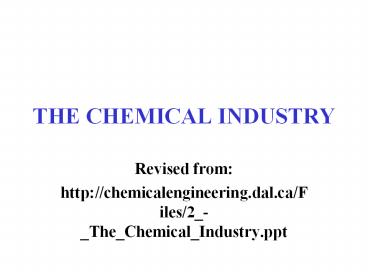THE CHEMICAL INDUSTRY - PowerPoint PPT Presentation
1 / 38
Title:
THE CHEMICAL INDUSTRY
Description:
THE CHEMICAL INDUSTRY Revised from: http://chemicalengineering.dal.ca/Files/2_-_The_Chemical_Industry.ppt – PowerPoint PPT presentation
Number of Views:286
Avg rating:3.0/5.0
Title: THE CHEMICAL INDUSTRY
1
THE CHEMICAL INDUSTRY
- Revised from
- http//chemicalengineering.dal.ca/Files/2_-_The_Ch
emical_Industry.ppt
2
OUTLINE
- Structure of the Chemical Industry
- Raw Materials and Energy
- Base Chemicals
- Chemical Processes
3
STRUCTURE OF THE CHEMICAL INDUSTRY
- Raw materials are converted into products for
other industries and consumers. - Basic raw materials can be divided into
- organic, and
- inorganic.
- Inorganic raw materials include
- air, water and
- minerals.
- Fossil fuels and biomass belong to the class of
organic raw materials.
4
Structure of the chemical industry
- About 85 of chemicals are produced from 20
simple chemicals called base chemicals. - Base chemicals produced from 10 raw materials.
- Base chemicals converted to 300 intermediates.
- Base chemicals and intermediates classified as
bulk chemicals. - About 30,000 consumer products are produced from
intermediates.
5
Structure of the chemical industry
6
Where these chemicals go..
- 12 of the cost of a car
- polyurethane seat cushions
- neoprene hoses and belts
- airbags and nylon seat restraints
- 10 of the cost of a house
- including the cost of important insulation
- pipes
- electrical wiring
- 10 of what the average household consumer buys
and uses every day - food products
- clothing
- footwear
- health and personal care products
- household cleansers
- home entertainment equipment.
7
(No Transcript)
8
From http//www.chem.tamu.edu/class/majors/chem47
0/Sulfuric_Acid-2008.PPT
9
From http//www.chem.tamu.edu/class/majors/chem47
0/Sulfuric_Acid-2008.PPT
10
Canadian Industry
11
Consumer products from raw materials
12
Structure of the chemical industry
- Coal, oil and natural gas (NG) are the primary
raw materials for production of most bulk
chemicals. - Each stage adds value
- Relative value
- Crude oil 1
- Fuel 2
- Typical petrochemical 10
- Typical consumer product 50
13
Overview of the petrochemical industry
14
Structure of the chemical industry
- First step in petrochemical industry is
conversion of raw materials into base chemicals. - Synthesis gas (H2 and CO) ?through steam
reforming of NG ? ammonia or methanol. - Lower alkenes through steam cracking of ethane or
naphtha ethene, propene, butadiene. - Aromatics through steam cracking of ethane or
naphtha or the catalytic reforming process
benzene, toluene, xylenes (BTX).
15
Structure of the chemical industry
- The second step involves a variety of chemical
processes often aimed at introducing various
hetero-atoms (O, Cl, S etc.) into the molecule. - This leads to formation of intermediates such as
acetic acid, formaldehyde, acetaldehyde and
monomers like acrylonitrile, terephthalic acid
etc. - The third step yields consumer products.
- The chemical industry can be conveniently divided
into 7 sectors.
16
World chemical market (1989)
17
World chemical industry
- World output 2.7 trillion
- Americas 34
- Asia/Pacific/Africa 32
- Europe 34
- In 2000, there were 1,200 establishments
operating in Canada. - They employed approximately 72,500 employees.
18
- In the USA, 70,000 chemical products in 12,000
plants, 95 in batch operations. - Top five organic chemicals ethylene, propylene,
ethylene dichloride, methyl-tert-butyl-ether
(MTBE), and vinyl chloride. - Top inorganic chemicals nitrogen, oxygen,
chlorine, and sodium hydroxide.
19
USA Petroleum IndustryUSA has 163 operating
refineries and 15.6 million barrels per day
20
USA Chemicals Industry
21
RAW MATERIALS AND ENERGY
- Raw materials and energy are closely related.
- Indeed, the main raw materials for the chemical
industry are fossil fuels. - These are also the most important sources of
energy. - Major energy source is oil (40), Coal ( 26),
then NG ( 21). - But reserves show a different picture!
22
Total world energy consumption
23
Fossil fuel reserves (reserves/production) for
1997
24
Petrochemical share of world oil
25
Energy and the chemical industry
- A lot of energy is used in the chemical industry
( same order as used for feedstock) - About 8 of crude oil demand is used as raw
material in the chemical industry the balance is
used for fuel production. - Fuels for direct heaters and furnaces
- often same as raw material, e.g. in steam
reforming of NG, the NG is used for both
feedstock and fuel. - Fuel oil (a product of distillation) is often
used to preheat feed to the crude oil
fractionator.
26
Energy and the chemical industry
- Steam
- Usually most important utility system.
- Used for process heating, a reactant, in
distillation. - It is used saturated, wet or superheated.
- Steam used is replaced by treated make-up water.
- Steam used at 3 pressures levels
- Operating Conditions Saturation
- Pressure (bar) Temp (K) Temp (K)
- HP 40 683 523
- MP 10 493 453
- LP 3 463 407
27
Steam/power generation
28
Energy and the chemical industry
- Electricity
- Can be generated in-plant or purchased from
utility. - Reduction of energy costs by generation of power
on-site with steam turbines and process heating
with exhaust gases. - Often economical to drive large compressors with
steam. - Co-generation (electricity and local/district
heating). - Integrated coal gasification combined cycle
(ICGCC) power generation (? is 41-43 vs 34-35
for PF / steam turbine).
29
BASE CHEMICALS
- Most important base chemicals are the lower
alkenes (ethene, propene and butadiene), the
aromatics (BTX), NH3 and CH3OH. - Syngas (a mixture of H2 CO) can be used as a
base chemical feedstock (e.g. Fischer-Tropsch). - Most chemicals can be produced directly or
indirectly from these building blocks. - Feedstock depends on location production unit.
30
Lower Alkenes from oil
31
Lower Alkenes from NG
32
Aromatics production
33
Ammonia and methanol production
34
Business-cash flowchart
35
Petroleum Industry Technologies
36
Chemicals Industry Technologies
37
Levels of development
38
Space and time scales































